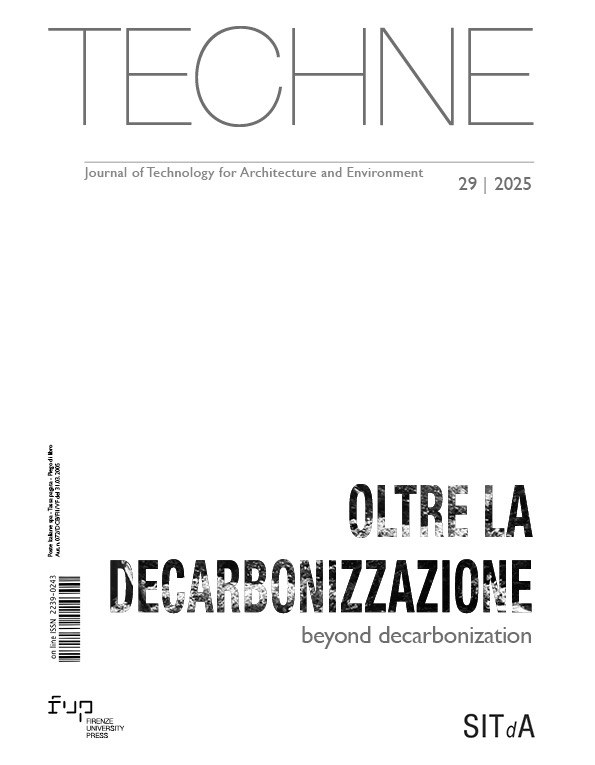Published 2025-07-31
Keywords
- Urban agriculture,
- city utopias,
- food security,
- sustainable urban regeneration
How to Cite
Copyright (c) 2025 Leonardo Zaffi, Michele D'Ostuni

This work is licensed under a Creative Commons Attribution 4.0 International License.
Abstract
Yona Friedman’s vision of employing Urban Agriculture to eliminate the city’s dependence on the countryside by liberating agricultural land from exploitation is more pertinent than ever. In a world where cities are sustained by food produced in increasingly remote locations and the environmental impact of the agri-food supply chain grows ever more unsustainable, it is imperative to reconsider the relationship between urbanised areas and food production. Advances in soil-free cultivation technologies present new opportunities to integrate productive vegetation into urban and residential spaces. If deprived of utopian connotations, this approach invites reflection on the need for innovative design paradigms that integrate the built environment with cultivated spaces, fostering widespread and symbiotic interactions to promote sustainable regeneration.
Downloads
References
- Arcas-Pilz, V., Gabarrell, X., Orsini, F. and Villalba, G. (2023), “Literature review on the potential of urban waste for the fertilization of urban agriculture: A closer look at the metropolitan area of Barcelona”. Science of the Total Environment. Available at: https://doi.org/10.1016/j.scitotenv.2023.167193 (Accessed on 10/09/2024). DOI: https://doi.org/10.1016/j.scitotenv.2023.167193
- Basso, S., Venudo, A., Bisiani, T. and Martorana, P. (2023), “Vertical farm. New architectures and cities from the forms of agriculture”, AGATHÓN – International Journal of Architecture, Art and Design, Vol. 13, pp. 141-152. Available at: https://arts.units.it/handle/11368/3050338 (Accessed on 10/09/2024).
- Carotti, L. et al. (2023), “Improving water use efficiency in vertical farming: Effects of growing systems, far-red radiation and planting density on lettuce cultivation”, Agricultural Water Management Vol. 285, p. 108365. DOI: https://doi.org/10.1016/j.agwat.2023.108365
- Despommier, D. (2010), The Vertical Farm: Feeding the World in the 21st Century, Mc Millan, New York.
- D’Ostuni, M., Zaffi, L., Appolloni, E. and Orsini, F. (2022), “Understanding the complexities of Building-Integrated Agriculture. Can food shape the future built environment?”, Futures, Vol. 144, p. 103061. Available at: https://doi.org/10.1016/j.futures.2022.103061. DOI: https://doi.org/10.1016/j.futures.2022.103061
- Ellen MacArthur Foundation (2019), Cities and circular economy for food. Available at : https://emf.thirdlight.com/file/24/K6LOnIrKMZq-8vK6HoTK6iyBra/Cities%20and%20circular%20economy%20for%20food.pdf (Accessed on 15/12/2024).
- Evans, D.L., Falagán, N., Hardman, C.A., Kourmpetli, S., Liu, L., Mead, B.R. and Davies, J.A. C. (2022), “Ecosystem service delivery by urban agriculture and green infrastructure–a systematic review”, Ecosystem Services, Vol. 54, p. 101405. Available at: https://doi.org/10.1016/j.ecoser.2022.101405. DOI: https://doi.org/10.1016/j.ecoser.2022.101405
- Friedman, Y. (2000), Utopies réalisables. Edition de l’eclat, Paris. Traduzione italiana (2003) Utopie realizzabili, Quodlibet, Macerata.
- Friedman, Y. (2003), L’architecture de survie.Une philosophie de la pauvreté, Edition de l’eclat, Paris. Traduzione italiana (2009) L’architettura di sopravvivenza. Una filosofia della povertà. Bollati Boringhieri, Torino.
- Fox-Kämper, R., Kirby, C. K., Specht, K., Cohen, N., Ilieva, R., Caputo, S. and Béchet, B. (2023), “The role of urban agriculture in food-energy-water nexus policies: Insights from Europe and the US”, Landscape and Urban Planning, Vol. 239, p. 104848. DOI: https://doi.org/10.1016/j.landurbplan.2023.104848
- Hamilton, H., Henry, R., Rounsevell, M., Moran, D., Cossar, F., Allen, K. and Alexander, P. (2020), “Exploring global food system shocks, scenarios and outcomes”. Futures, Vol. 123, p. 102601. Available at: https://doi.org/10.1016/j.futures.2020.102601. DOI: https://doi.org/10.1016/j.futures.2020.102601
- Holt-Giménez, E. (2019), Can we feed the world without destroying it?, John Wiley & Sons. Cambridge.
- Ilieva, R.T., Cohen, N., Israel, M., Specht, K., Fox-Kämper, R., Fargue-Lelièvre, A. and Blythe, C. (2022), “The socio-cultural benefits of urban agriculture: a review of the literature”, Land, Vol. 11, n. 5, p. 622. Available at: https://doi.org/10.3390/land11050622. DOI: https://doi.org/10.3390/land11050622
- Ipsos (2023), Perils of Perception, Prejudice and Conspiracy Theories. Available at: https://www.ipsos.com (Accessed on 28/11/2024).
- Kane, J. (2016), The architecture of pleasure: British amusement parks 1900-1939. Routledge. Available at: https://doi.org/10.4324/9781315612539. DOI: https://doi.org/10.4324/9781315612539
- Koolhaas, R. and Obrist, H.U. (2011), Project Japan – Metabolism Talks, Taschen, Colonia.
- Kozai, T., Niu, G. and Takagaki, M. (Eds) (2019), Plant factory: an indoor vertical farming system for efficient quality food production. Academic press.
- Labatut, B. (2019), Quando abbiamo smesso di capire il mondo, Adelphi, Milano
- Naidu, R., Biswas, B., Willett, I.R., Cribb, J., Singh, B.K., Nathanail, C.P. and Aitken, R.J. (2021), “Chemical pollution: A growing peril and potential catastrophic risk to humanity”, Environment International, Vol. 156. Available at: https://doi.org/10.1016/j. DOI: https://doi.org/10.1016/j.envint.2021.106616
- Oecd, F.A.O. (2022), OECD-FAO agricultural outlook 2023-2032. Available at: https://openknowledge.fao.org/items/42b06e57-de39-446d-bc18-8e94056374ee.
- Orsini, F. and Zauli, I. (2022), “Where to go for sustainable and feasible vertical farming? A journey through resource use, environmental performances and viability indicators”. In XXXI International Horticultural Congress (IHC2022): International Symposium on Advances in Vertical Farming 1369, pp. 117-124. DOI: https://doi.org/10.17660/ActaHortic.2023.1369.14
- Orsini, F., Pennisi, G., Michelon, N., Minelli, A., Bazzocchi, G., Sanyé-Mengual, E., et al. (2020), “Features and functions of multifunctional urban agriculture in the global north: a review”, Front. Sustain. FoodSyst., Vol. 4, p. 562513. Available at: doi: 10.3389/fsufs.2020.562513 (Accessed on 28/07/2024). DOI: https://doi.org/10.3389/fsufs.2020.562513
- Perego, J. (2023), “Per coltivare in città l’orto è sul tetto del supermercato”, La Repubblica. Available at: https://www.repubblica.it/green-and-blue/2023/05/25/news/orto_urbano_tetto_bruxelles-401566294/ (Accessed on 30/07/2024).
- Stanghellini C., Katzin,D. (2024), ”The dark side of lighting: A critical analysis of vertical farms’ environmental impact”, Journal of Cleaner Production, Vol. 458, p. 142359. Available at: https://doi.org/10.1016/j.jclepro.2024.142359 (Accessed on 05/07/2024). DOI: https://doi.org/10.1016/j.jclepro.2024.142359
- UN – United Nations (2024), World population Prospects. The 2024 Revision. Available at: https://population.un.org/wpp/ (Accessed on 26/07/2024).
- Van Tuijl, E., Hospers, G.J. and van den Berg, L. (2018), “Opportunities and Challenges of Urban Agriculture for Sustainable City Development”, European Spatial Research and Policy, Vol. 25, n. 2, pp. 5-22. Available at: dx.doi.org/10.18778/1231-1952. DOI: https://doi.org/10.18778/1231-1952.25.2.01
- Wheeler, R.M. (2022), NASA’s contributions to vertical farming. In XXXI International Horticultural Congress (IHC2022): International Symposium on Advances in Vertical Farming 1369, pp. 1-14. DOI: https://doi.org/10.17660/ActaHortic.2023.1369.1






